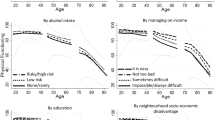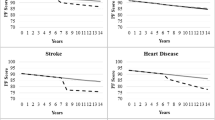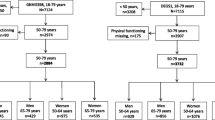Abstract
Purpose
Decline in physical function is common in older age, with important consequences for health-related quality of life, health care utilisation, and mortality. This study aimed to identify patterns of change in physical functioning (PF) for women in later life.
Methods
PF was measured longitudinally using the ten-item subscale of the Medical Outcomes Study 36-item Short Form Health Survey, for 10 515 participants of the Australian Longitudinal Study on Women’s Health, who completed at least two surveys between 1999 (aged 73–78 years) and 2011 (aged 85–90 years). Conditional and unconditional latent profile analysis was conducted separately for deceased and surviving subgroups of women to uncover latent patterns of change in PF scores over time.
Results
Four patterns of change were identified for women who were still alive in 2011 (N = 5928), and four similar classes for deceased women (N = 4587): (1) ‘poor PF’ representing women with low PF scores, (2) ‘moderate PF’, (3) ‘high PF’, and (4) ‘very high PF’, where scores remained very high. All patterns exhibited a decrease in PF over time. Factors which predict low PF included sedentary levels of exercise, obese and overweight BMI, difficulty managing on income, and lower education.
Conclusions
The results provided evidence for a gradual decrease in PF for all women with age; however, there was no evidence for an increased rate of decline prior to death.



Similar content being viewed by others
References
Christensen, K., Doblhammer, G., Rau, R., et al. (2009). Ageing populations: The challenges ahead. Lancet, 374, 1196–1208.
Litwin, H., Shira, A., & Schmotkin, D. (2012). Self-reported functional status among the old-old: A comparison of two Israeli cohorts. Journal Aging Health, 24(5), 846–862.
Sibbritt, D. W., Byles, J. E., & Regan, C. (2007). Factors associated with decline in physical functional health in a cohort of older women. Age and Ageing, 36, 382–388.
Rowe, J. W., & Kahn, R. L. (1997). Successful aging. The Gerontologist, 37(4), 433–440.
Fries, J. F. (1982). The compression of morbidity. The Milbank Memorial Fund Quarterly, 61(3), 397–419.
Gerstorf, D., & Ram, N. (2013). Inquiry into terminal decline: Five objectives for future study. Gerontologist, 53(5), 727–737.
Ahacic, K., Parker, M. G., & Thorslund, M. (2003). Mobility limitations 1974–1991: Period changes explaining improvement in the population. Social Science and Medicine, 57, 2411–2422.
Wang, Z., Zeng, Y., Jeune, B., et al. (1997). A demographic and health profile of centenarians in China. In J. M. Robine, et al. (Eds.), Longevity: to the limits and beyond (pp. 91–104). New York: Springer.
Chatterji, S., Byles, J., Cutler, D., et al. (2014). Health, functioning, and disability in older adults - present status and future implications. The Lancet, 14(6), 1462–1468.
Gill, T. M., Guo, Z., & Allore, H. G. (2008). Subtypes of disability in older persons over the course of nearly 8 years. Journal of the American Geriatrics Society, 56, 436–443.
Hsu, H.-C., & Jones, B. L. (2012). Multiple trajectories of successful aging of older and younger cohorts. Gerontologist, 52(6), 843–856.
Beckett, L. A., Brock, D. B., Lemke, J. H., et al. (1996). Analysis of change in self-reported physical function among older persons in four population studies. American Journal of Epidemiology, 143(8), 766–778.
Seidel, D., Jagger, C., Brayne, C., et al. (2009). Recovery in instrumental activities of daily living (IADLs): findings from the Medical Research Council Cognitive Function and Ageing Study (MRC CFAS). Age and Ageing, 38(6), 663–668.
Dobson, A, Hockey,R., Brown W.J., et al. (2015) Cohort Profile Update: Australian Longitudinal Study on Women’s Health. International Journalof Epidemiology. Published online 30/6/2015.
Ware, J. E., Kosinski, M., & Keller, S. D. (1994). SF-36 physical and mental health summary scales: A user’s manual. Boston, MA: The Health Institute.
Bohannon, R. W., & DePasquale, L. (2010). Physical functioing scale of the Short-Form (SF) 36: Internal consistency and validity with older adults. Journal of Geriatric Physical Therapy, 33, 16–18.
Lyons, R. A., Perry, H. M., & Littlepage, B. N. C. (1994). Evidence for the validity of the short-form 36 questionnaire (SF-36) in an elderly population. Age and Ageing, 23(3), 182–186.
Bartsch, L., Butterworth, P., Byles, J., et al. (2011). Examining the SF36 in an older population: Analysis of data from the Dynamic Analyses to Optimise Ageing (DYNOPTA) project. Quality of Life Research, 20(8), 1227–1236.
Taft, C., Karlsson, J., & Sullivan, M. (2001). Do SF-36 summary component scores accurately summarize subscale scores? Quality of Life Research, 10(5), 395–404.
World Health Organization. Obesity and Overweight. Fact sheet 311 [WHO Web site]. 2011 March, 2013 6 February, 2014]; http://www.who.int/mediacentre/factsheets/fs311/en/index.html.
Russell, A., j. Ball, W.J. Brown, et al. Physical activity - Survey 2 and latr surveys. 2001 [cited 2016 9th June].
Powers, J., Ball, J., Adamson, L., et al. (2000). Effectiveness of the National Death Index for establishing the vital status of older women in the Australian Longitudinal Study on Women’s Health. Australian and New Zealand Journal Public Health, 24, 526–528.
Collins, L.M. and S.T. Lanza, Latent Class and Latent Transition Analysis with Applications in the Social, Behavioural and Health Sciences Wiley Series in Probability and Statistics, ed. D.J. Balding, et al. 2010, Hoboken, New Jersey: John Wiley & Sons.
Muthén, B. and Muthén L.K. (1998–2012) MPLUS User’s Guide. Seventh Edition. Muthén & Muthén: Los Angeles, CA.
Nylund, K. L., Asparouhov, T., & Muthen, B. (2007). Deciding on the number of classes in Latent Class Analysis and Growth Mixture Modeling: A Monte Carlo simulation study. Structual Equation Modeling, 14(4), 535–569.
Celeux, G., & Soromenho, G. (1996). An entropy criterion for assessing the number of clusters in a mixture model. Journal of Classification, 13, 195–212.
Women’s Health Australia, Technical Report 37. 2014, University of Newcastle and University of Queensland: http://www.alswh.org.au/images/content/pdf/technical_reports/report_37_alswh.pdf.
SAS Institutute Inc., SAS/STAT Software, Version 9.4. http://www.sas.com/. Cary, NC.
Silverwood, R. J., Nitsch, D., Pierce, M., et al. (2011). Characterizing longitudinal patterns of physical activity in mid-adulthood using latent class analysis: results from a prospective cohort study. American Journal of Epidemiology, 174(12), 1406–1415.
Lanza, S. T., & Collins, L. M. (2006). A mixture model of discontinuous development in heavy drinking from ages 18 to 30: The role of college enrollment. Journal of Studies on Alcohol, 67(4), 552–561.
Goodman, L. A. (1974). The analysis of systems of qualitative variables when some of the variables are unobservable. Part I - A modified latent structure approach. American Journal of Sociology, 79, 1179–1259.
Botoseneanu, A., Allore, H. G., Gahbauer, E. A., et al. (2013). Long-term trajectories of lower extremity function in older adults: Estimating gender differences while accounting for potential mortality bias. The Journal of Gerontology A: Biology Science Medical Science, 68(7), 861–868.
Sliwinski, M. J., Stawski, R. S., Hall, R. B., et al. (2006). On the importance of distinguishing pre-terminal and terminal cognitive decline. European Psychologist, 11, 172–181.
Wilson, R. S., Beck, T. L., Bienias, J. L., et al. (2007). Terminal cognitive decline: Accelerated loss of cognition in the last years of life. Psychosomatic Medicine, 69, 131–137.
Gerstorf, D., Ram, N., Mayraz, G., et al. (2010). Late-life decline in well-being across adulthood in Germany, the United Kingdom, and the United States: Something is seriously wrong at the end of life. Psychology and Aging, 25, 477–485.
Fries, J. F., Bruce, B., & Chakravarty, E. (2011). Compression of morbidity 1980-2011: A focused review of paradigms and progress. Journal of Aging Research, 261702, 1–10.
Xu, X., Liang, J., Botoseneanu, A., et al. (2014). Socioeconomic stratification and multidimensional health trajectories: evidence of convergence in later old age. The Journal of Gerontology B: Psychological Science Social Science, 70(4), 661–671.
Heesch, K.C., Miller, Y.D., & Brown, W.J. (2007) Relationship between physical activity and stiff or painful joints in mid-aged women and older women: a 3 year prospective study. Arthritis Resaerch and Therapy, 9(2), R34.
Jamrozik, K., McLaughlin, D., McCaul, K., et al. (2011). Women who smoke like men die like men who smoke: Findings from two Australian cohort studies. Tobacco Control, 20, 258–265.
Brown, W. J., Dobson, A. J., Bryson, L., et al. (1999). Women’s Health Australia: On the progress of the main cohort studies. Journal of Womens Health and Gender-Based Medicine, 8(5), 681–689.
Hockey, R., Tooth, L., & Dobson, A. (2011). Relative survival: a useful tol to assess generalisability in longitudinal studies of health in older persons. Emerging Trends in Epidemiolgy, 8(1), 3.
Brilleman, S., Pachana, N., & Dobson, A. (2010). The impact of attrition on the representativeness of cohort studies of older people. BMC Medical Research Methodology, 10, 71.
Beswick, A. D., Rees, K., Dieppe, P., et al. (2008). Complex interventions to improve physical function and maintain independent living in elderly people: A systematic review and meta-analysis. Lancet, 371, 125–135.
Acknowledgments
This research was conducted as part of the Australian Longitudinal Study on Women’s Health (ALSWH), the University of Newcastle and the University of Queensland. We are grateful to the Australian Government Department of Health and Ageing for funding, to the staff of ALSWH, and to the women who provided the survey data. Researchers in the Research Centre for Generational Health and Ageing at the University of Newcastle are members of the Hunter Medical Research Institute (HMRI), Newcastle. We acknowledge the assistance of the Data Linkage Unit at the Australian Institute of Health and Welfare (AIHW) for undertaking the data linkage to the National Death Index (NDI). GDM is funded by the Australian Research Council Future Fellowship (FT120100812).
Funding
The ALSWH is funded by the Australian Government Department of Health and Ageing. Gita D Mishra is funded by the Australian Research Council Future Fellowship (FT120100812). Lucy Leigh is a PhD Candidate receiving an Australian Postgraduate Award Scholarship
Author information
Authors and Affiliations
Corresponding author
Ethics declarations
Conflict of interest
Lucy Leigh, Julie E Byles, Gita D Mishra declare no conflicts of interest.
Ethical approval
All procedures (surveys) performed in studies involving human participants were in accordance with the ethical standards of the institutional and/or national research committee and with the 1964 Helsinki Declaration and its later amendments or comparable ethical standards.
Informed consent
Informed consent was obtained from all individual participants included in the study.
Additional information
Lucy Leigh and Julie E. Byles are joint first authors.
Rights and permissions
About this article
Cite this article
Leigh, L., Byles, J.E. & Mishra, G.D. Change in physical function among women as they age: findings from the Australian Longitudinal Study on Women’s Health. Qual Life Res 26, 981–991 (2017). https://doi.org/10.1007/s11136-016-1422-3
Accepted:
Published:
Issue Date:
DOI: https://doi.org/10.1007/s11136-016-1422-3




